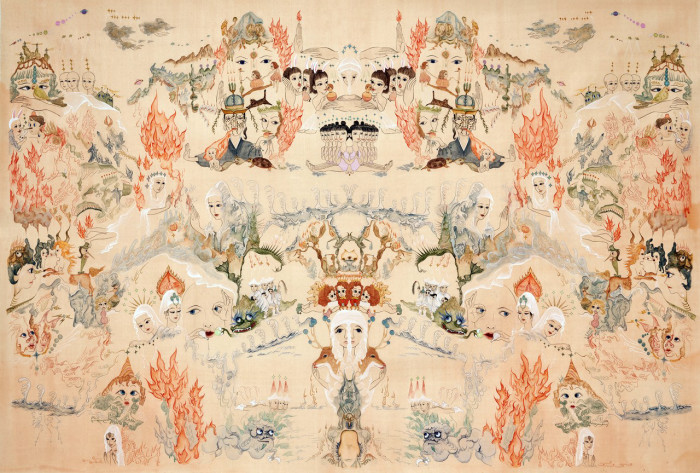Son Donghyun is a contemporary South Korean artist who defies the conventions of traditional Korean paintings, such as figure paintings, Munjado (pictorial ideographs), Sipjangsaengdo (ten longevity symbols painting), and other Minhwa (Korean folk art).
He has not only been recognized in the Korean contemporary art scene for his artistic practices but has also gained public recognition for painting traditional portraits of figures from popular culture.

Son Donghyun. Courtesy of the artist.
One of his most well-known works is Portrait of the King, a series of 40 works that began in 2008. In this group of paintings, Son depicted Michael Jackson in Korean traditional artistic styles using traditional techniques, forms, and media.
The portraits depict different aspects of Michael Jackson. Son portrays him as a meritorious vassal before he earned the title “King of Pop,” and as a king sitting on Korean thrones.
In Korean traditional portraits during the Joseon Dynasty (1392-1910), it was considered important to not only paint the subject in its proper colors but also to capture the subject’s spirit and outlook on life. To reflect Jackson’s spirit in the paintings, Son went through extensive research on his albums and music videos, his physiognomic changes, as well as his life history to create this series.

Son Donghyun's solo exhibition "Ink on Paper III" at Gallery2, Seoul. March 3 to April 2, 2022. Photo by Aproject Company.
As an artist who constantly experiments with traditional Korean paintings, Son presented a new group of works that took a slightly different direction from his earlier works at his recent solo exhibition.
Son’s three-part exhibition project, “Ink on Paper”, was held at Gallery2 in Pyeongchang-dong, Seoul, in 2015, 2020, and most recently from March 3 to April 2. Each show experimented with traditional painting materials such as meok (traditional ink), ink, and hanji (traditional Korean paper) to experiment in art-making practice.
In his third “Ink on Paper” exhibition, Son attempted to bring most of the unique features of hanji through sumuk-sansuhwa (水墨 山水畫; Korean ink landscape paintings). Traditional hanji is made from the inner bark of mulberry trees, which is crushed into compact fibers; thus the paper sometimes has tiny gaps between the fibers and absorbs liquid more easily than today’s paper. On the other hand, hanji is more durable. A crumpled piece of hanji can easily return to its original plain state when sprayed with water, and its robust nature makes it possible to make folded paper books or folding fans.
To emphasize these characteristics of the Korean paper, Son used only meok, which settles nicely on Korean paper, unlike his previous works which used various colors. He also noticed that no information about paintbrushes, which are necessary for paintings, is provided in any captions or labels, and interpreted this as an open option to draw landscapes without using paintbrushes.

Son Donghyun's solo exhibition "Ink on Paper III" at Gallery2, Seoul. March 3 to April 2, 2022. Photo by Aproject Company.
The artist crumples up hanji and sprays meok with a spray or stencil to express the rugged mountain terrain, and then sprays water to make the paper flat after the ink is completely dried. He also used toy train rails to draw waterfalls and expressed dragons and dark clouds on folded paper books and folding fans.
Rather than reinterpreting the traditional form of landscape painting, the artist tried to reflect the free spirit of old landscape painters.
Old landscape paintings were mainly done by the literati rather than professional painters. These scholars focused on expressing the essence of the subject and their ideology instead of capturing the scenery in the exact details. It was most important to them to express their thoughts on the Taoist’s flow of life in the landscape.
Son considered the artistic practices of the scholars as a play and stretched this idea to his artworks by using various unconventional tools and methods to create the landscape paintings.
His intentions were shown throughout the exhibition. For example, Son made a miniature landscape with small works to express a dragon playing freely in a landscape of falling waterfalls.

Son Donghyun's solo exhibition "Ink on Paper III" at Gallery2, Seoul. March 3 to April 2, 2022. Photo by Aproject Company.
Son Donghyun’s experimental mind is also reflected in the process of making works.
He juggled between the two and three dimensions through the process of crumpling and unfolding hanji, as well as the process of making a flat picture into a folding book or a folding fan.
He also breaks down the boundaries of the screens by combining various techniques into a single screen, and by taking out each element that would fit into a single screen into smaller mounting pieces and composing each work as if they were connected to each other.
The works of Son Donghyun have been introduced by renowned art institutions, including the National Museum of Contemporary Art, Korea, (MMCA) the Seoul Museum of Art (SeMA), the Horim Museum of Art, and the SongEun Art Foundation. In recognition of his originality and novelty, he received the Young Artist Award presented by the Ministry of Culture, Sports and Tourism in 2017, and the SongEun Art Award in 2015.
Son is also participating in Aproject Company’s K-ARTIST.COM, an online archive and art market platform that aims to raise global recognition of acknowledged Korean contemporary artists.
Son Donghyun’s artworks will be presented in an upcoming group exhibition, Praise of Life, held at the National Museum of Modern and Contemporary Art in Gwacheon, from May 18 to October 9, 2022.


















